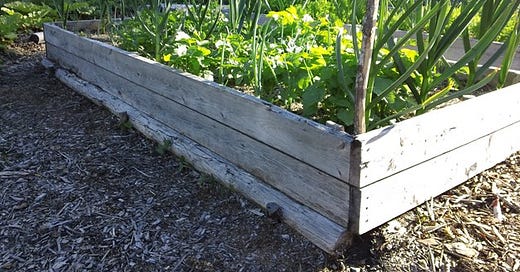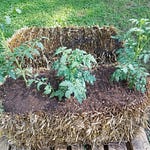Raised beds seem to be all the rage among new gardeners these days. People seem to love the way they look, and love the results that they get with their raised beds. But here's the thing — you don't need raised beds to have a great garden, and that’s a good thing because the price of lumber these days is insane.
If your goal is to have a highly productive garden at a low cost, you can totally opt out of this fad and still have a garden that is the envy of your neighborhood!

There is something very appealing about the aesthetic that raised beds bring to a garden.
In the same manner that a well-designed deck can greatly augment the feel of a backyard, raised beds seem to add an appealing geometry to a gardening space. But here's the thing — the plants could absolutely care less. All they want is good sun, healthy soil, and constant moisture levels. In this article I want to present an alternative view, for those who are considering raised beds this season.
The Good
If you have poor soil, raised beds offer a quick solution, because rather than work with the existing soil, you just make a box and fill it with good soil from somewhere else. If you have a drainage problem, raised beds are a good way to get the plant roots up a little higher above the soil’s natural water table. Finally, if the box is built high enough, it can reduce back strain, which can be an important feature for those who have back problems or other mobility issues. Despite these benefits, I would argue that the cons outweigh the pros by far.
Con 1: Defying Gravity
First and foremost, the biggest drawback of raised beds is that they position your plants above grade, and above ground level where water is naturally more abundant. It makes no sense to try to grow something that requires water by making your first move one that makes it harder for the plant to reach the water. Unless you enjoy standing around with a hose, or wish to invest in an extensive drip irrigation system, raised beds are inefficient by design because they make it hard for plants to find water in the absence of human intervention.
Con 2: Unsustainable
All of the money and time that you put into your raised beds constitute a pyrrhic victory at best. The weeds that you think you have thwarted, will eventually find their way in if they are really invasive and persistent. The wood is destined to rot and will need replacing. The good soil that you brought in (from some other ecosystem), will become depleted over time. And finally, the effort (constant watering) and/or money (drip irrigation) that is required to ensure constant moisture levels in your soil will at least be equal to any advantage that is to be gained by adopting raised beds in your garden.
Con 3: Totally Unnecessary
If you could go back in time to the '70s when I was a kid, you would find backyard gardens in every neighborhood, all of them at ground level, and all doing just fine. In my experience, raised beds are more about style than gardening. We like the way they look. The wood. The 90-degree angles. The sense of order. All of these elements appeal to us on many subconscious levels. I personally think this speaks to a broader malaise in our culture in the sense that we seem to place a higher value on appearances than on utility; and while I understand that aesthetics are an important aspect of life, when it comes to gardening for food, I consider them a secondary concern. My goal is to grow as much food as possible, in as little space, with as little time and money invested as possible. For me, permaculture design is the way forward for achieving that goal.

Building healthy soil
The simplest approach to gardening is to work with the soil you have. In my backyard (bought this piece of land in 2011) I literally had clay and rock to work with in the beginning. Using simple border materials (rocks, logs, and two-by-six lumber) I defined my garden spaces, worked in four inches of horse manure, and added a mulch on top of the soil. That year (2014) I had an extraordinary garden, and every year it just gets easier and better. The soil is now very productive, and I have never used a rototiller in the 2,500-square-foot area where my garden grows, and I rarely need to water. That's gardening with nature, rather than in opposition to it. That's copying systems that work in nature, and putting them to use in your garden. That's permaculture design, and it all starts with building healthy soil.
Healthy soil starts with the understanding that the soil is a complex system of living things, and not unlike an organism in the sense that it constitutes a whole that is greater than the sum of its parts. It is up to you to create an environment that is favorable to all the living things in your soil. That means ensuring constant moisture levels and a steady supply of nutrients. What better way to do that than by building your garden at ground level (where the water and most of the important organisms already are) and by mulching your soil. In this way, over the long run you do less work, because the mulch helps the soil retain moisture (solving the watering problem), and the organisms in your soil break down organic matter into key nutrients (solving the fertilization problem) as well as move the soil around, keeping it nice and loose (solving the tilling problem).

But hey, it's hard working at ground level!
Yes, it can be, but unless your raised beds are very high, you will still have to bend down anyway. I think that, unless you have serious mobility issues, it is better to look at the bending, crouching and kneeling as good exercise or perhaps a crude form of yoga, rather than work. Think of how much time and money people put into their exercise programs, while yours, by contrast, will cost nothing and yield healthy food.
Final thoughts
So that's my take on the whole raised bed thing. I'm not trying to rain on anyone's parade, and of course, if you have them and like them, chacun à son goût, as the French say. My main point is that if you are considering putting a garden in, do not fall into the trap of thinking that raised beds are the only path to success. None of my “raised beds” are higher than six inches above grade. In fact, the majority are less than that, and they all bear excellent yields every year. So if you have a thing for wooden rectangles, that’s fine - but given the cost of lumber these days, remember that there’s nothing to be gained by going any higher than 6 inches. Happy gardening!













Share this post